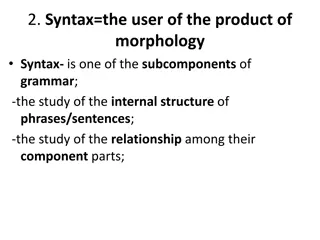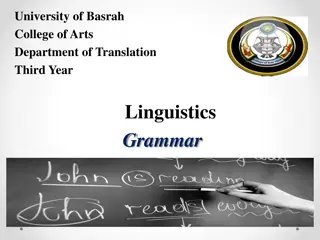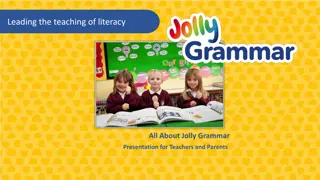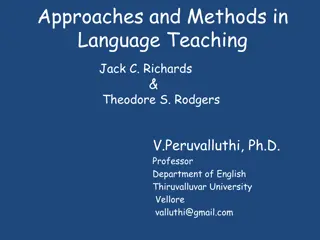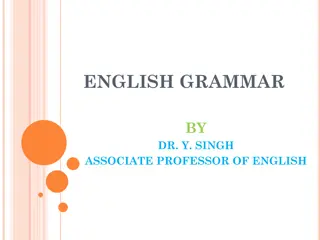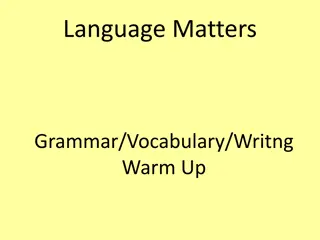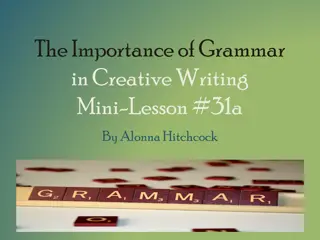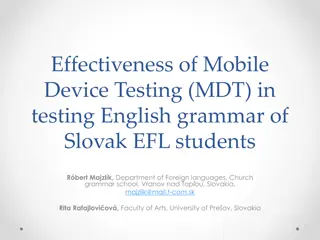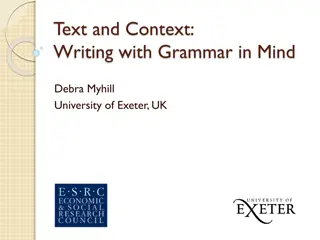Principles of Teaching Grammar: Key Recommendations and Session Outline
Explore the principles of teaching grammar outlined by Dr. Rowena Kasprowicz and Professor Emma Marsden, focusing on providing explicit descriptions, practice in input and productive language use, utilization of standard terminology, and building on knowledge from key stage 2. The session outline covers background information, the necessity of grammar teaching, explaining grammatical rules, practicing with standard terminology, and building on prior learning. Understand the different approaches to grammar teaching - explicit, implicit, and focus on meaning, form, and forms. Delve into the question of whether grammar should be taught and how instruction can impact learning rates and paths.
Download Presentation

Please find below an Image/Link to download the presentation.
The content on the website is provided AS IS for your information and personal use only. It may not be sold, licensed, or shared on other websites without obtaining consent from the author. Download presentation by click this link. If you encounter any issues during the download, it is possible that the publisher has removed the file from their server.
E N D
Presentation Transcript
Principles of Teaching Grammar Dr Rowena Kasprowicz & Professor Emma Marsden
MFL Pedagogy Review General principles Grammar is a key part of communication Grammatical knowledge is cumulative Certain bits of grammar are problematic and need to be taught directly Key recommendations Provide an explicit but succinct description of the grammatical feature to be taught Provide practice of the grammar point in input language (reading / listening) Provide practice in productive use of the features being taught Practice productive use in free writing and speech in a range of contexts Utilise standard grammatical terminology Build on knowledge developed at key stage 2 Meaningful practice (Tomorrow morning) (Bauckham, 2016)
Session Outline A bit of background What do we mean by grammar teaching? Should we teach grammar? Principles underpinning the key recommendations Explaining the grammatical rule Practising in input language Using standard terminology & Building on KS2 learning
What Do We Mean By Grammar Teaching? any instructional technique that draws learners attention to some specific grammatical form in such a way that it helps them either to understand it metalinguistically and/or process it in comprehension and/or production so that they can internalise it (Ellis, 2006, p. 84) Explaining a grammatical rule Practice recognising a grammatical feature in reading / listening Practice using a grammatical feature in writing / speaking Discovering new grammatical rules incidentally Feedback on errors
What Do We Mean By Grammer Teaching? (Explicit) (Implicit) Focus on MEANING Provide extensive input Grammar features acquired naturally No explicit instruction or feedback Focus on FORM Incidental Exposure through communicative activities Notice grammar features that cause difficulty Focus on FORMS Intentional Pre-planned Grammar taught in isolation Mechanical drills (Long & Robinson, 1998)
Should We Teach Grammar? Instruction can speed up the rate of learning (e.g. White, Spada, Lightbown, & Ranta, 1991) and Instruction can influence the route of learning (e.g. Avery & Marsden, under review; N. Ellis, 2006; McManus & Marsden, 2017, 2018; Murakami & Alexopoulou, 2016; Tolentino & Tokowicz, 2014) but dependent upon the grammar feature and learner characteristics (L1-L2, individual differences) and more evident for some contexts, tasks and tests than others
Should We Teach Grammar? The accuracy with which a particular grammar feature is acquired is influenced by salience complexity communicative usefulness frequency context in which it is used (DeKeyser, 2005)
Should We Teach Grammar? Instruction can be beneficial (e.g. Norris & Ortega, 2000, 2001; Spada & Tomita, 2010) Substantial learning gains following (any) instruction Learning gains tend to be durable More explicit types of instruction > More implicit types of instruction For simple and complex grammatical forms On more controlled (e.g. gap-fill) & free tasks (e.g. conversational)
Should We Teach Grammar? We learn things we pay attention to (e.g. Schmidt, 1990, 2001) Learners need to notice (consciously register) a grammar feature for it to be learned Instruction: Focus learners attention on particular parts of the language (Sharwood-Smith, 1993) consciousness-raising activities (Sharwood-Smith, 1993) (Implicit) learning from exposure takes a long time
The Key Recommendations Provide an explicit but succinct description of the grammatical feature to be taught Provide practice of the grammar point in input language (comprehension) Provide practice in productive use of the features being taught Practice productive use in free writing and speech in a range of contexts Utilise standard grammatical terminology Build on knowledge developed at key stage 2
Explicit, Succinct Description of the Grammatical Feature Example: French 1stperson present vs. Past tense (Marsden, 2006) Present Je fais Past Explain the grammatical rule J ai fait J ai dit Je dis Focus on one pair of meanings The problem is that learners of French often write and say je faire or je fait not j ai. Perhaps they find this difficult because je and j ai sound a bit similar! Explain the problem(s) the learner might encounter Also, words like 'le weekend dernier' already tell us it is in the past, so we don't notice j ai.
Explicit, Succinct Description of the Grammatical Feature Fast and accurate use of the language feature Knowledge about how to use a language feature Knowledge about a language feature Extensive, repeated, meaningful practice (DeKeyser, 2015)
Explicit, Succinct Description of the Grammatical Feature Providing an explanation can help learners to break down and organise the language they hear / read (Terrell, 1991) notice particular language features (Schmidt, 1990) pick up language features more quickly (e.g. Henry, et al., 2009) Deductive approaches > Inductive approaches (Erlam, 2003; Robinson, 1996)
Explicit, Succinct Description of the Grammatical Feature May not be essential to learning, if practice fosters inductive learning (i.e. practice pushes learners to attend to the grammatical feature and work out the rules) (DeKeyser & Prieto-Botana, 2015) Explanation + practice vs. Practice only equivalent learning outcomes (e.g. Benati, 2004; Farley, 2004; Marsden, 2006; VanPatten & Oikennon, 1996) BUT Facilitative effect of providing explanation before practice Explanation + practice vs. Practice only Speed up the learning process (e.g. Henry, et al., 2009; Henry, et al., 2017; VanPatten & Borst, 2012) Particularly beneficial for more complex grammatical forms (e.g. Fern ndez, 2008)
Explicit, Succinct Description of the Grammatical Feature Awareness of L1-L2 differences relates to L2 performance (Ammar, Lightbown, & Spada, 2010) Is information about the L1 and L1-L2 differences also useful? Providing information about grammatical meanings that are mapped differently in L1 / L2 can be beneficial (e.g. McManus & Marsden, 2017; McManus & Marsden, 2018; McManus & Marsden, 2019)
Explicit, Succinct Description of the Grammatical Feature L1&L2 information and practice improvement in reading and listening Remapping concepts and reinforcing correct L2 form-meaning mappings (McManus & Marsden, 2017; 2018) Two forms in French could map onto one form in English Il jouait au foot Il a jou au foot (Trying used to could help to disambiguate) He played football... One form in French could map onto two forms in English Il jouait au foot quand j ai appel . quand nous tions petits. He was playing football, when I called. He played football, when we were little.
The Key Recommendations Provide an explicit but succinct description of the grammatical feature to be taught Provide practice of the grammar point in input language (comprehension) Provide practice in productive use of the features being taught Practice productive use in free writing and speech in a range of contexts Utilise standard grammatical terminology Build on knowledge developed at key stage 2
Practice of the Grammar Point In Input Language In pairs / small groups, discuss the example activities taken from standard Key Stage 3 textbooks. Discuss these questions: Which grammar feature(s) are the activities practising? What are the activities asking the students to do? What are the activities asking the students to pay attention to?
Practice of the Grammar Point In Input Language Common elements in typical grammar activities: Introduce whole paradigm / multiple grammatical features Something missing? Reading / Listening practice requiring attention to the grammatical feature Written / aural texts providing lots of examples Focus on content words; possible for learners to complete activities without paying attention to the key grammatical feature(s) Scaffolded production practice; possible for learners to copy patterns without paying attention to the function/meaning of the grammatical feature(s)
Practice of the Grammar Point In Input Language Why is it important to give learners practice paying attention to grammar in input language ? Some grammar features are particularly hard to notice and learn Some grammar features are often overlooked / ignored by learners Lack of accuracy in learners use of particular grammatical features Le garcon m appelle Le weekend dernier je manger
Practice of the Grammar Point In Input Language Do these mistakes matter? Natural, developmental errors Chunks are very useful Too much emphasis on accuracy = demotivating! Need fluency, complexity, risk-taking No BUT Yes Useful to breakdown and analyse chunks Gradually become more accurate in using grammar
Practice of the Grammar Point In Input Language Why are certain bits of grammar problematic? Low frequency? Poor knowledge of rules? BUT these do not fully explain the errors Noticing and extracting some features of the input seems to be difficult
Why Are Certain Grammar Features Problematic? One reason: Another part of the sentence might express a similar meaning And learners are familiar with or expect that part Le weekend dernier j ai mang Ignored! It happened in the past!
Feed ONE robot or ALL of the robots? Practising present tense 1stperson singular/plural verb endings in French High accuracy when pronoun is present Drop in accuracy when pronoun is removed Increase in accuracy when attention is on the verb ending
Why Are Certain Grammar Features Problematic? Low communicative salience (VanPatten, 2004) Meaning expressed by another, more salient element of the sentence More salient cue overshadows less salient, cue (N. Ellis 2006) Prior knowledge of more salient cues (e.g. temporal adverbs) can block learning of other cues (e.g. verb inflections) (N. Ellis 2006) Low perceptual salience e.g. inflections (N. Ellis, 2006) Hard to hear / easy to overlook Often short and not stressed / emphasised Fluent speakers perceive such elements with top-down support of existing language knowledge Importance of building knowledge of verbs to facilitate learning of inflections
Why Are Certain Grammar Features Problematic? One reason: English habits entrenched Der Mann verfolgt den Hund. Subject (almost) always comes first in English Ignored!
Why Are Certain Grammar Features Problematic? Some cues are more reliable in some languages than others (MacWhinney, 2002) Then man chased the dog. The dog chased the man. Der Mann verfolgt den Hund. Den Hund verfolgt der Mann. Different meaning Same meaning Learners apply the reliable cues from their L1, when interpreting the L2 e.g. L1 English learners rely on word order and overlook case marking in L2 German (even though case marking is more reliable in German) (e.g. Jackson, 2007; Kasprowicz & Marsden, 2017; MacWhinney, 2002)
Why Are Certain Grammar Features Problematic? Understanding a new language through the lens of our previous language experience (N. Ellis, 2006) Existing (L1) form-meaning associations compete for attention with new associations Similarities / differences between L1 and L2 Positive / negative transfer
Why Are Certain Grammar Features Problematic? One reason: Common sense, expectations The children The man works in a bank. Children don t work in banks! Ignored!
Practice of the Grammar Point In Input Language Reading & Listening What can we do? Focused practice in input language to draw learners attention to problematic grammatical features and make those grammatical features matter by temporarily removing the cues that learners rely on.
Practice of the Grammar Point In Input Language Form-meaning mapping 50+ experimental studies (in classrooms, as well as laboratories) since early 1990s, e.g. French verb inflections with 11 to 14 year olds (Marsden, 2006) German case marking with 9 to 11 year olds (Kasprowicz & Marsden, 2017) Evidence suggests benefits for: Improving analysis of language Training the ear to notice small phonemic differences (e.g. je / j ai) Improving comprehension and production A range of ages, proficiencies, languages, grammar features
Practice of the Grammar Point In Input Language Example: English present tense subject-verb agreement (3rdperson singular vs plural) The following sentences have become jumbled. Underline who you think does the activities: Separated subject noun phrase and verb and removed real world expectations walks the dog 1. The cat / parents work in a bank 2. The child / men Use verb inflection and connect to meaning to identify the subject of the sentence 3. The baby / parents cry all night listen to the news 4. The child / adults
Practice of the Grammar Point In Input Language Example: French 1stperson present versus past tense with avoir (je vs. j ai) Listen to these people talking about what they normally do at the weekend and what they did last weekend. You will hear each sentence twice. You will hear the whole sentence but the only clue is whether you hear je (something happens regularly) or j ai (past). Removed temporal adverb and kept main verb constant (no phonemic difference between present tense and past participle, e.g. fais vs. fait) 1. Normalement Le weekend dernier 2. Normalement Le weekend dernier 3. Normalement Le weekend dernier Use presence/absence of auxiliary and connect to meaning to identify the tense 4. Normalement Le weekend dernier 5. Normalement Le weekend dernier (Marsden, 2006)
Practice of the Grammar Point In Input Language Example: German definite article case marking for masculine nouns (der vs. den) 1. Der Affe begr t den Panda. A B Removed word order cue and removed real world expectations 2. Den L wen erschreckt der Hamster. A Use case marking and connect to meaning to identify subject and object B (Kasprowicz & Marsden, 2017)
Practice of the Grammar Point In Input Language Avoid working with whole paradigms at one time, particularly in the first stages of language learning Attention is a limited resource; learners can only pay attention to so much at any one time (Lee & VanPatten, 1995; VanPatten, 2002; Wong, 2004) Focus on accurate and reliable knowledge of one form juxtaposed with another (e.g. je joue vs. nous jouons) Provide plenty of practice for each pair of grammatical forms/meaning Gradually build up wider system
The Key Recommendations Provide an explicit but succinct description of the grammatical feature to be taught Provide practice of the grammar point in input language (comprehension) Meaningful practice (tomorrow morning) Provide practice in productive use of the features being taught Practice productive use in free writing and speech in a range of contexts Utilise standard grammatical terminology Build on knowledge developed at key stage 2
Utilise Standard Grammatical Terminology Utilise Standard Grammatical Terminology Build on Knowledge Developed at key Stage 2 KS2 English curriculum: Grammar should be taught explicitly: pupils should be taught the terminology and concepts set out in English Appendix 2, and be able to apply them correctly to examples of real language, such as their own writing or books that they have read.
Utilise Standard Grammatical Terminology Build on Knowledge Developed at key Stage 2 KS2 languages curriculum: understand basic grammar relevant to the language being studied, including (where relevant): feminine, masculine and neuter forms and the conjugation of high-frequency verbs; key features and patterns of the language; how to apply these, for instance to build sentences; and how these differ from or are similar to English
Utilise Standard Grammatical Terminology Build on Knowledge Developed at key Stage 2 Issues around transition, but: Extensive learning about L1 English grammar (SPaG test in Year 6 SATs) at KS1 and KS2 (At least some) foreign language grammar teaching is happening at KS2 And Sense of progression key to motivation and engagement (Graham et al, 2016) Younger learners can benefit from instruction in grammar (Kasprowicz & Marsden, 2017; Lichtman, 2016; Marsden & Chen, 2011) Drawing comparisons between English and another language is useful (McManus & Marsden, 2017) Younger learners are able to engage in analysis of language , if taught how to (Bouffard & Sarkar, 2008)
Summary Lots of evidence that teaching grammar is helpful Many factors that can make grammar difficult to learn (hard to perceive, differences with L1, meaning duplicated elsewhere) Useful to keep these in mind when planning what to teach, when, and how Drawing learners attention to these potential causes of difficulty can be useful Make sure there are opportunities for practice where the learner has to pay attention to the grammar and its meaning
References Ammar, A., Lightbown, P., & Spada, N. (2010). Awareness of L1/L2 differences: Does it matter? Language Awareness 19(2), 129-146. Avery & Marsden (under review) A meta-analysis of sensitivity to grammatical information during self-paced reading in a second language. Bauckham, I. (2016). Modern foreign languages pedagogy review: A review of modern foreign languages teaching practice in key stage 3 and key stage 4. Teaching Schools Council Benati, A. (2004). The roles of explicit information and structured input. In B. VanPatten (Ed.), Processing instruction: Theory, research, and commentary. Mahwah, NJ: Lawrence Erlbaum Associates. DeKeyser, R. (2015). Skill acquisition theory. In B. VanPatten & J. Williams (Eds.), Theories in second language acquisition: An introduction (pp. 94 112). London, UK: Routledge. DeKeyser, R., & Prieto Botana, G. (2015). The effectiveness of processing instruction in L2 grammar acquisition: A narrative review. Applied Linguistics, 36, 290 305. Dulay, H., & Burt, M. (1974). Natural sequences in child second language acquisition. Language Learning, 24(1), 37-53. Ellis, N. (2006). Selective attention, and transfer phenomena in L2 acquisition: Contingency, cue competition, salience, interference, overshadowing, blocking, and perceptual learning. Applied Linguistics, 27(2), 164-194. Erlam, 2003). The effects of deductive and inductive instruction on the acquisition of direct object pronouns in French as a second language. The Modern Language Journal, 87(2), 242-260. Farley, A. P. (2004). Processing instruction and Spanish ser and estar: Forms with semantic-aspectual values. In B. VanPatten (Ed.), Processing instruction: Theory, research, and commentary. Mahwah, NJ: Lawrence Erlbaum Associates. Fern ndez, C. (2008). Re-examining the role of explicit information in Processing Instruction. Studies in Second Language Acquisition, 30, 277 305. Graham, S., Courtney, L., Tonkyn, A., & Marinis, T. (2016). Motivational trajectories for early language learning across primary-secondary school transition. British Educational Research journal, 42(4), 682-702.
References Harley, B. (1992). Patterns of second language development in French immersion. French Language Studies, 2, 159-183. Henry, N., Culman, H., & VanPatten, B. (2009). More on the effects of explicit information in instructed SLA. Studies in Second Language Acquisition, 31, 559 575. Henry, et al., 2017; The role of prosody and explicit instruction in processing instruction. The Modern Language Journal, 101(2), 1-21. Keck, C. & K, Y-J. (2015). Pedagogical grammar. Amsterdam: John Benjamins Publishing Company. Horst, M., White, J., & Bell, P. (2010). First and second language knowledge in the language classroom. International Journal of Bilingualism, 14, 331 349. Krashen, S. (1982). Principles and practice in second language acquisition. Pergamon Press Inc. Long, M., & Robinson, P. (1998). Focus on form: Theory, research, and practice. In, C. Doughty, & J. Williams (eds), Focus on form in classroom second language acquisition (pp. 15-41). Cambridge: Cambridge University Press. Marsden, E. (2006). Exploring input processing in the classroom: An experimental comparison of processing instruction and enriched input. Language Learning, 56, 507 566. Marsden, E., & Chen, H.-Y. (2011). The roles of structured input activities in processing instruction and the kinds of knowledge they promote. Language Learning, 61, 1058 1098. Marsden, E., & David, A. (2008). Vocabulary use during conversation: A cross-sectional study of development from year 9 to year 13 among learners of Spanish and French. Language Learning Journal, 36, 181 198 McManus, K. & Marsden, E. (2017). L1 explicit instruction can improve L2 online and offline comprehension. Studies in Second Language Acquisition, 39, 459-492. McManus, K. & Marsden, E. (2018). Online and offline effects of L1 practice in L2 grammar learning: A partial replication. Studies in Second Language Acquisition, 40, 459-475.
References McManus, K. & Marsden, E. (2019). Signatures of automaticity during practice: Explicit instruction about L1 processing routines can improve L2 grammatical processing. Applied Psycholinguistics. Murakami, A., & Alexopoulou, T. (2016). L1 influence on the acquisition order of English grammatical morphemes. Studies in Second Language Acquisition, 28, 365-401. Norris, J., & Ortega, L. (2001). Does type of instruction make a difference? Substantive findings from a meta-analytic review. Language Learning, 51(S1), 157-213. Robinson, P. (1996). Learning simple and complex second language rules under implicit, incidental, rule search, and instructed conditions. Studies in Second Language Acquisition, 18, 27-67. Schmidt, R. (1990). The role of consciousness in second language learning. Applied Linguistics, 11(2), 129-158. Spada, N., & Tomita, Y. (2010) Interactions between type of instruction and type of language feature: A meta-analysis. Language Learning, 60(2), 263-308. Terrell, T. (1991). The role of grammar instruction in a communicative approach. The Modern Language Journal, 75(1), 52-63. Tolentino, L., & Tokowicz, N. (2014). Cross-language similarity modulates effectiveness of second language grammar instruction. Language Learning, 64, 279 309. VanPatten, B. (2002). Processing instruction: An update. Language Learning, 52(4), 755-803. VanPatten, B., & Borst, S. (2012). The role of explicit information and grammatical sensitivity in processing instruction: Nominative-accusative case marking and word order in German L2. Foreign Language Annals, 45, 495 510. VanPatten, B., & Oikkenon, S. (1996). Explanation versus structured input in processing instruction. Studies in Second Language Acquisition, 18, 495 510. White, L., Spada, N., Lightbown, P., & Ranta, L. (1991). Input enhancement and L2 question formation. Applied Linguistics, 12(4), 416-432.



